CHAPTER XIII.
The Fugue with Less or More Than Four Parts. — The Three-Voice Fugue.
138. The Exposition. The three parts are called lower, inner, and upper, without reference to voice-compass, though they are likely to represent adjacent registers. The regular Exposition contains Subject, Response, and Subject (comp. par. 123), the last Subject always either an octave higher or lower than the first Subject.
The enlargement of the Exposition to four announcements is, however, quite common in the 3-voice Fugue; the last announcement is again “Response,” usually an 8ve lower or higher than the first Response.
See Bach, Well-temp. Cl., Vol. I, Fugue 19; the 4th announcement is made noticeable by the peculiar leap in Bass (meas. 5–6).
Vol. I, Fugue 8 (meas. 12). Vol. II, Fugue 11 (meas. 21). Vol. II, Fugue 19 (meas. 7).
139. The Theme of a 3-voice Fugue is likely to be of a more spirited rhythmic character, and possibly wider compass, than that of the 4-voice Fugue; otherwise there is no essential difference. The structural designs and all details of treatment are the same.
140. Sectional form. Review pars. 128 to [par.] 132, and analyze the following, most thoroughly:
Bach, Well-temp. Cl., Vol. I, Fugue 9; Exposition to meas. 5; Sec. II to meas. 17; episode in meas. 13–15, recurring in meas. 23–24; in meas. 19 there is an intimation of a return to the beginning (quasi 3-Part Song-form). Vol. I, Fugue 11, four Sections.
Vol. II, Fugue I. — Fugue 6 (contrary motion and stretti employed in later course). — Fugue 10 (episode in meas. 18–20, corroborated in meas. 47–49; characteristic Counterpoint recurs occasionally). — Fugue 11 (quasi 2-Part Song-form; Exposition to meas. 29; many episodes). — Fugue 12. Fugue 15. Fugue 19.
Bach, Clavichord Comp., Peters ed. 212, No. 2 (p. 59). Peters ed. 213, No. 1, 2nd movement; elaborate episodes. Peters ed. 213, No. 2, 2nd movement (p. 21); broad sectional form; elaborate episodes, largely similar. Peters ed. 214, No. 2 (p. 12); many fairly strong cadences, Sections small; compare minutely with the “Variante,” p. 48. Peters ed. 215, p. 23. 216, p. 50 (No. 8, fifth movement). 216, No. 10 (p. 57); many cadences, Sections brief.
Bach, Musikalisches Opfer, No. 1 (Ricercata, — same as Fuga).
Rubinstein, Fugue op. 53, No. 2 (contrary motion and stretti ingeniously used).
Schumann, op. 126, No. 1 (2 Sections, cadences vague); No. 6, 4 Sections.
Jadassohn, Pfte. Fugues and Preludes, op. 56; Fugue No. 6; also Nos. 2 and 3 — the latter contain effective stretti and the Contrary motion, — cited again, among the Concert-fugues (par. 148).
141. Two-Part Song-form. Review par. 135, and analyze the following:
Bach, Well-temp. Cl., Vol. I, Fugue 6; Part I closes in meas. 21 (almost exactly in the middle of the Fugue) with a strong perfect cadence in the Dominant key; Part II uses the contrary motion freely, and later, from meas. 31 on, corroborates Part I closely; the last 5 measures of each Part correspond exactly (except in key).
The Fugue as Gigue form (par. 51), with contrary motion as basis of Part II, is illustrated in Bach, Org. Comp., Vol. I, “Pastorale,” last movement.
142. Among the many devices adopted for the characterization of the Second Part (the most common being the contrary motion of the Theme, pars. 48b, [par.] 51), there is one that is peculiarly effective in the Fugue, namely, the introduction of a new and striking Counterpoint, retained more or less constantly throughout the Part, as new thematic member. This process was touched upon in Ex. 156, which see. For illustration see —
Bach, Well-temp. Cl., Vol. I, Fugue 13; Part I (Exposition and episodic extension) closes in meas. 11; the new “thematic counterpoint” appears in meas. 12–13 in Bass, and twice later; it grows out of the foregoing episodic figure (meas. 7).
Vol. II, Fugue 21; Part I to meas. 32; the thematic counterpoint is in Soprano, meas. 33–36, and reappears often; the two Parts close alike.
Vol. II, Fugue 24; the form is sectional (no decisive cadence to mark a First Part); the thematic counterpoint first occurs in meas. 29–32, in Bass.
Händel, Clav. Suite, No. 4, 1st movement; 4-voice.
This design is the type of the Double-fugue, Third Species (par. 178, class I.
143. The Three-Part Song-form. Review par. 136, and see —
Schumann, op. 72, Fugue 2; light cadence at end of Part I (Exposition); the first figure of the Counterpoint is used constantly; the contrary motion of the Theme appears in later course of Part II; Part III contains only fragments of Theme, — a end in Augmentation.
The Second Part is strongly characterized by an animated rhythmic counterpoint in Bach, Well-temp. Cl., Vol. I, Fugue 19; Part I ends in meas. 20; an interlude of 3 measures follows, leading into Part II (meas. 23); the animated counterpoint is not exactly “thematic” (that is, it has no definite and permanent thematic form), but is based upon a set of similar figures; Part III, meas. 42, falls back into the original quiet rhythm, which again yields to the animated form during the Coda (meas. 49). This form corresponds to par. 70. Comp. also par. 142.
The 5-Part Song-form (two digressions, Parts II and IV, and two returns to the beginning, Parts III and V) is illustrated in —
Rubinstein, Pfte. Fugue, op. 53, No. 5; effective use of Diminution and stretti.
144. The Special Design. Review par. 137, and see —
Bach, Well-temp. Cl., Vol. I, Fugue 8; the Exposition ends in meas. 19; Sec. II contains stretti, and a curious partial Augmentation (Alto, meas. 24–27); Sec. III meas. 30, is an Exposition of the contrary motion; Sec. IV, meas. 44, closely resembles Sec. II (in contrary motion); Sec. V, meas. 52–61, contains triple stretti in regular and contrary motion, and one regular (single) announcement of the Theme; Sec. VI, meas. 61–83, is an Exposition of the Augmentation (Bass, Alto, Soprano); the rest is an extremely beautiful Codetta. Vol. I, Fugue 15; Sec. I, Exposition, to meas. 20; followed by an Exposition of the contrary motion; and later, various stretti; analyze thoroughly. The episodic sections in this Fugue are very distinct, and corroborative of each other.
The 2-Voice Fugue.
145. The Fugue with two parts only is naturally rare, because such slender means are inadequate to the dignity and richness that distinguish this polyphonic form.
The Theme must be of a lively rhythmic character, and ample compass. Episodes are frequent and somewhat free (brilliant); and the occasional addition of an auxiliary part, or parts, is permissible, — almost necessary. See —
Bach, Well-temp. Cl., Vol. I, Fugue 10; very clearly defined 2-Part Song-form; Part I closes (with a unique passage in intentional octaves) in meas. 20, in the Sub-dominant key; Part II, which follows immediately, is an exact reproduction of the First Part, but with inverted voices, and, on the first beat of meas. 29, a shift to the next higher step, in order to cadence upon the original keynote, e, instead of d (as would be the case if the preceding Subdominant modulation were pursued). Compare meas. 29 with meas. 10. Part II ends, with the same octave-passage, in meas. 39; the rest is Codetta (Theme in Soprano, pried asunder by an interposed measure, with imitation of first half in Bass).
Rheinberger, op. 5, No. 3.
Bach, Duetto II (Peters ed. 208, No. 4), 3-Part form. Also Duetto III (with exceptional auxiliary part at beginning — par. 112, 2); 3-Part form.
The 5-Voice Fugue.
146. The extra, 5th, part is either a second Soprano, second Tenor, or second Bass (rarely an additional Alto); and the compass as a whole is somewhat expanded, either by adding to the height of the usual Soprano, or the depth of the Bass, or both.
Review par. 123. The Exposition consists of Subject, Response, Subject, Response, Subject. The “Subjects” must be an octave apart; the “Responses” likewise. Parallel parts (those which are to announce the “Subject”), be it recalled, are separated by one (or three) parts.
Five-voice Fugues are seldom effective for the pianoforte, but entirely so for organ. In any case, however, it is desirable to use rests frequently; especially protracted rests which reduce the texture occasionally to 4-voice, or even 3-voice. Review, carefully, par. 134d and par. 75e.
The Subject is usually brief, stately, and narrow in range.
The very positive difficulties attending the addition of a 5th part may be minimized: (1) by preserving a perfectly distinct consciousness of the chord-basis, and the harmonic progressions in general; (2) by sustaining at least one of the parts upon some lengthy tone, important in the chord (as root), or in the key (Tonic, Dominant), — that is, by refraining from leading all the parts abreast, in active rhythm; (3) by using many parallel 3rds and 6ths and reciprocal figures, illustrated in Exs. 113 and [ex.] 114 (which see); and (4) by judicious use of brief rests.
For general illustration:
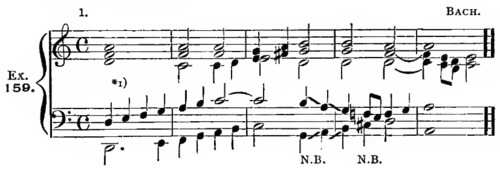
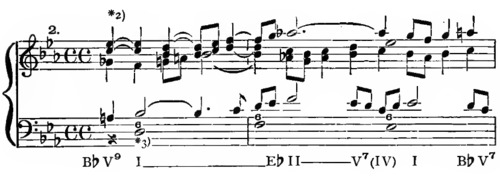
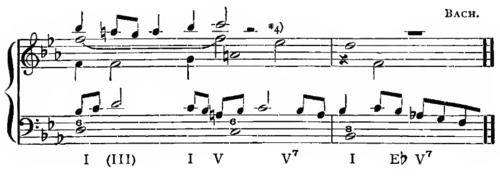
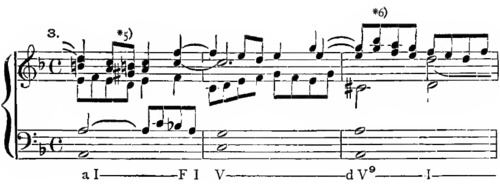
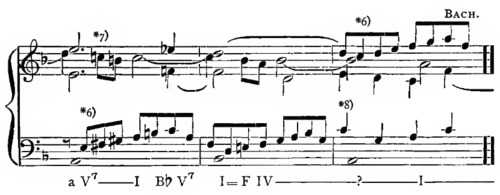
*1) Observe the profusion of parallel 3rds.
*2) Parallel 3rds and 6ths.
*3) The two basses run in 6ths constantly. Observe the thematic character of the first (highest) bass part; the very definite melodic conduct of both outer parts; and the chord-analysis.
*4) From here on, 4-voice texture.
*5) A neighboring-chord.
*6) The Motive (in 8th-notes).
*7) C♮ substituted for the expected c♯ (par. 19c).
Analyze, very minutely, the harmony, thematic texture, and form of the following:
Bach, Well-temp. Cl., Vol. I, Fugue 22; Two-Part Song-form; Part II, beginning in meas. 25, contains three well-defined Sections; in the last Section there is a double announcement of the Theme in 3rds (in the two Sopranos), and a five-fold stretto (beginning in meas. 9 from the end).
Bach, Org. Comp., Vol. II, Fugue 5; a fine example; 5 Sections; many different effective “Counterpoints”; after the Exposition the rhythm is more animated; Secs. III and V are largely 3- and 4-voice texture.
Vol. II, Fugue 7; Special design; the Theme is brief, and almost constantly present (i.e., few episodes); the texture is 4-voice up to Sec. VI, when the Pedal enters with Augmentation of Theme (to the end); Sec. II, meas. 8, begins with a striking sequential Counterpoint in the Soprano (see par. 134b); Sec. IV is an Exposition of the contrary motion; Sec. V contains stretti in regular and contrary motion.
Vol. II, Fugue 6; Two-Part Song-form; 6 announcements in the Exposition; in Part II there is a new thematic Counterpoint (see par. 142), utilized first in abbreviated form, as a long 3-voice episode (meas. 59–86).
Vol. III, Fugue 4; begins with “Response”; 7 Sections and Coda; many effective episodes, somewhat homophonic in character.
Vol. IV, Fugue 1, also begins with “Response”; it is 4-voice texture, with occasional brief intimations of a 5th part.
Jadassohn, Pfte. Fugues, op. 56; Fugue No. 9; sectional.
Fugue with Six and More Parts.
147. It is very uncommon to employ more than five parts in the Fugue, or any other strictly polyphonic form, not only because of the technical difficulty, but chiefly that of rendering the form intelligible. As the parts are multiplied, the style becomes more and more harmonic, and all voice-individuality is lost. The most effective device consists in so using protracted rests that, for the most part, no more than 5 of the voices appear at one time together. In any case, the extent will rarely exceed that of a Fughetta.
See Bach, Musikalisches Opfer, No. 2, Ricercata (i.e., Fugue) for 6 parts.
An example of 6-voice writing may be found in Bach, Org. Comp., Vol. VI, No. 13 (Fugue-group, par. 157).
Further, Bach, “B-minor Mass,” No. 20 (Second Division, Pleni sunt coeli); vocal fugue, par. 152; properly speaking, only a Fughetta.
Bach, 8-voice motets (vocal, — Peters ed. 28), No. 2, Allegro non tanto; 8-voice double quartet; first announcement of Theme in 1st Soprano, accompanied; followed by 8 Imitations in the other parts.
Motet No. 4, letter C to D; 8-voice Exposition. Also the following Vivace.
EXERCISE 42.
A. Four or more examples of the 3-voice Fugue, respectively in sectional form (par. 140), 2-Part Song-form (pars. 141 and [par.] 142), 3-Part Song-form (par. 143), and with Special Design (par. 144). Employ different species of measure and different tempo for each, and alternate major and minor modes.
B. An example of the 2-voice Fugue.
C. Two examples of the 5-voice Fugue, for organ.
D. A Fughetta (one Section) with 6 parts, for organ.